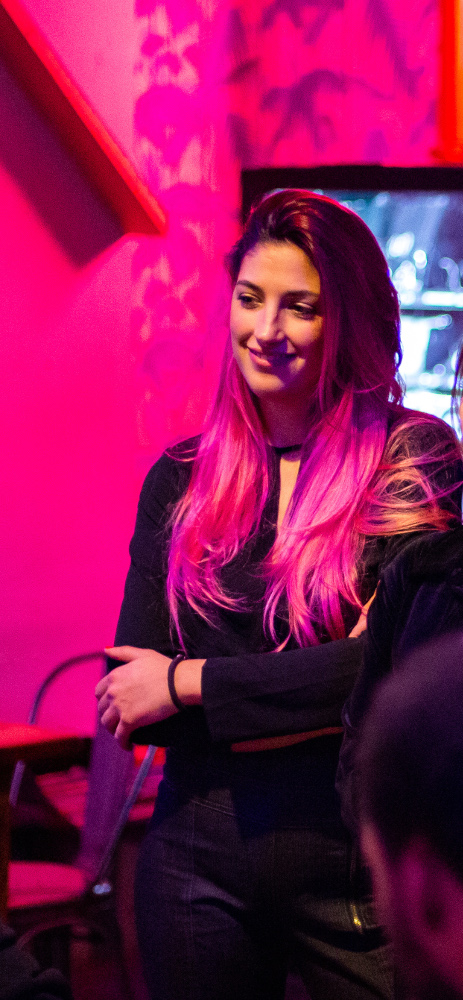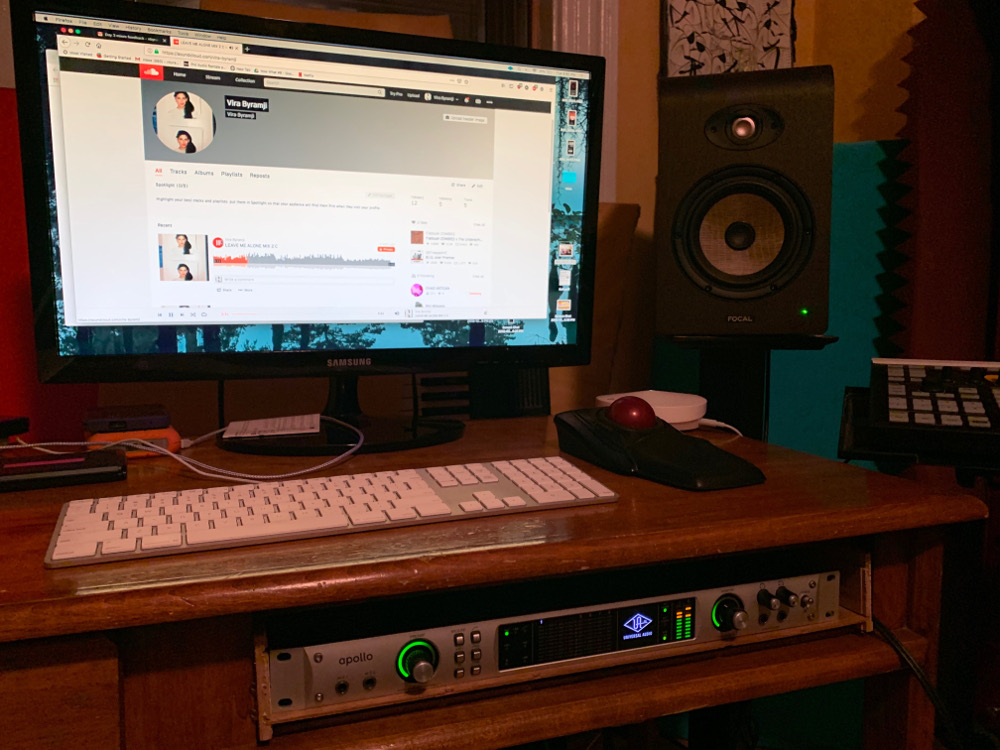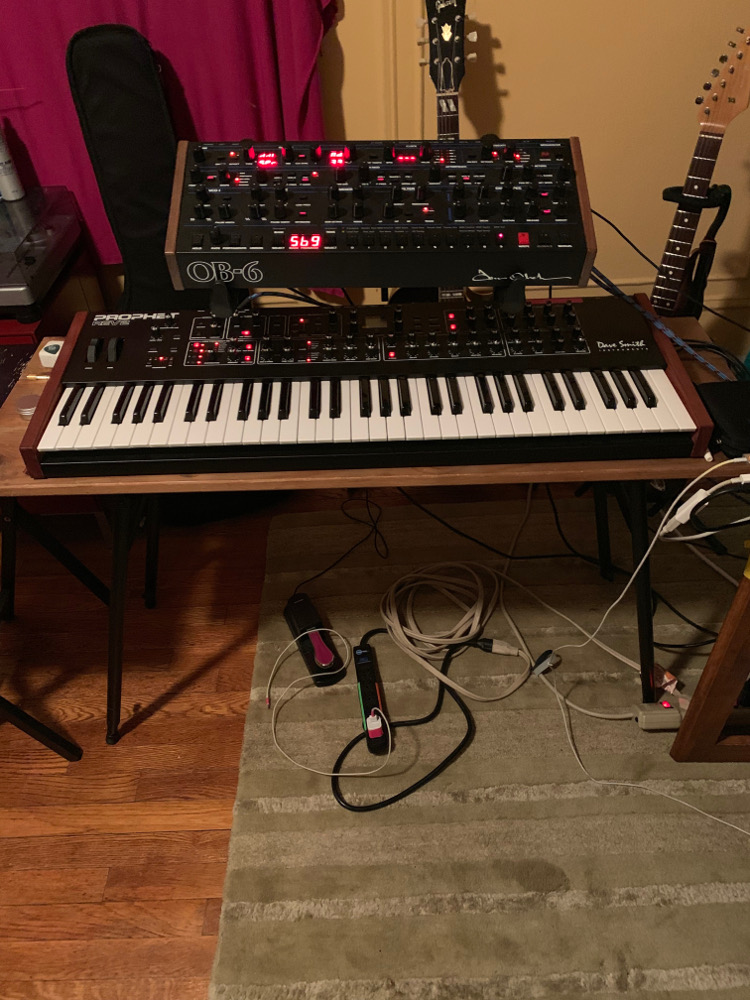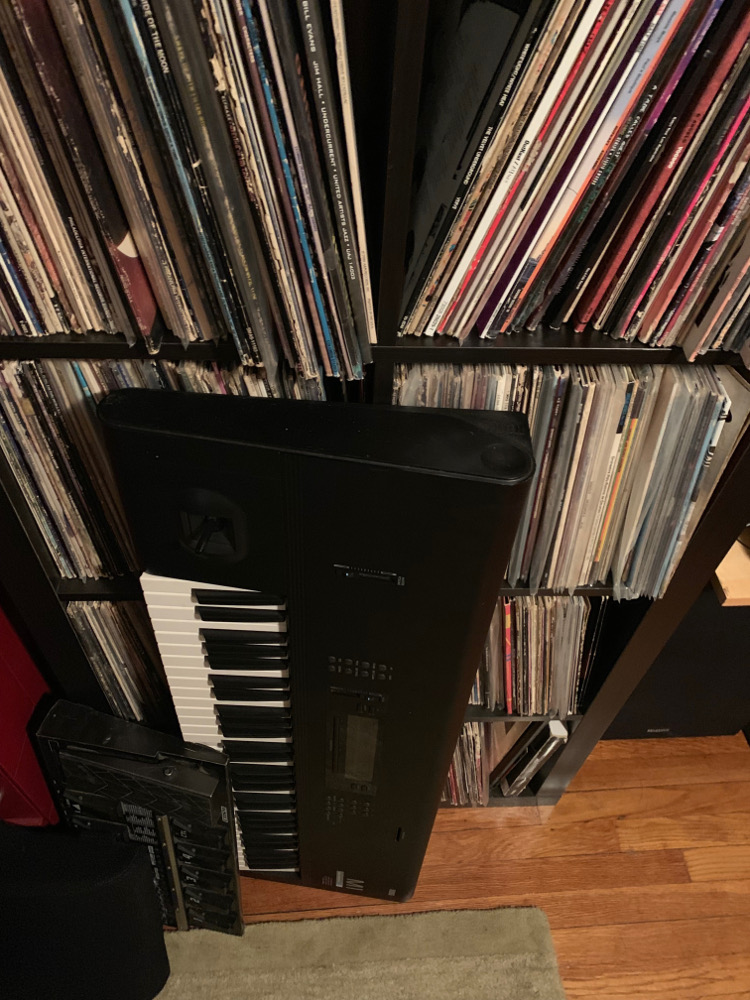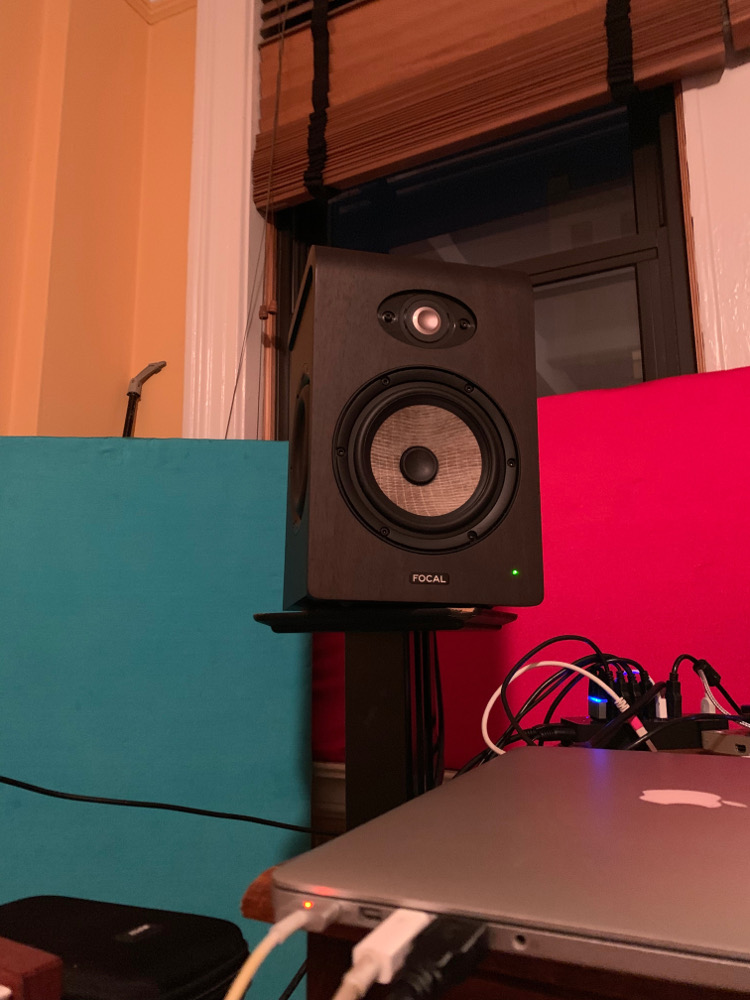Lessons from Electric Lady: How Vira Byramji Tuned her Personal Mix Room
Listen in.
That’s the common theme that you’ll find in mixer/engineer Vira Byramji’s approach for building a busy audio practice. It’s not just her clients’ music that she trains her ears on, however, but something more: Their words, vibe, and overarching objectives are all part of the information spectrum that Byramji considers carefully when she’s recording and mixing.
The personal studio that she’s helming on Manhattan’s Upper West Side may seem distant from the legendary Electric Lady Studios where she built up her career, but this apartment setup has more in common with the famed downtown facility than you might think. As a former assistant studio manager at Electric Lady, Byramji got to observe the best practices of a bevy of elite audio practitioners — including resident geniuses like Michael Brauer, Tom Elmhirst, and John O’Mahony — sharpening their craft on a daily basis.
As a result, Byramji’s UWS mix space makes the most of its setting, a converted bedroom that now serves as a suite for a serious sweet spot. Drawing on her ears, experience, and some select reference tracks, she converted the simple space into a high-functioning mix room where she can go right to work for her selective clientele that includes Roger Waters & Lucius, Patti Smith, Father John Misty, The Lie and more.
Byramji’s discography is growing quickly, but she’s not just living her life in between a pair of Focals. She’s also building up her creative colleagues as the co-founder of Now What, a casual networking event that meets monthly and serves the NYC music community through inclusive and open discussion.
It’s just one more way that this emerging mixer is listening in. Read on for SonicScoop’s first “Mix Suite Signal Path” and gain deeper insights into how Vira Byramji fine-tuned a regular room into an accurate audio environment that translates, the tight gear list she selected, and how she hones in with laser accuracy on her clients’ all-important sonic visions.
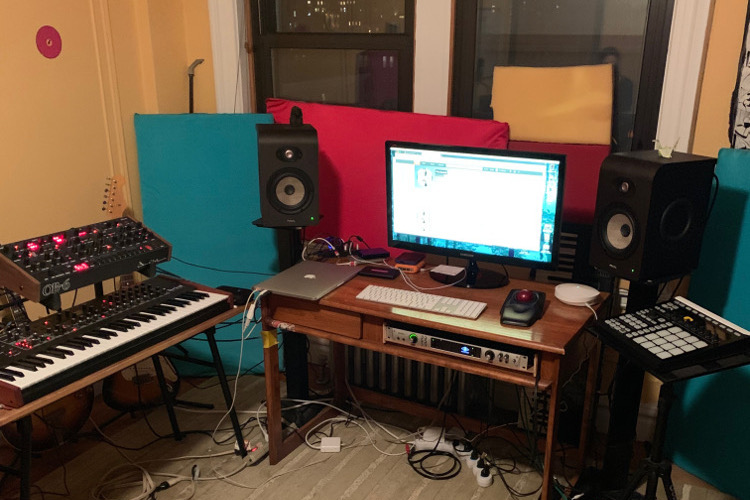
Surrounded by sound: Byramji converted an Upper West Side residential room into a high-functioning mix suite.
Mix Suite Signal Path
Mixer: Vira Byramji
Location: Manhattan, NYC
Clients/Credits: Patti Smith – M Train (Engineer, Audio Book), Father John Misty – Pure Comedy (Engineer), Banks & Steelz (Engineer), The Lie (Upcoming Film, Mix Engineer), Roger Waters & Lucius – Us & Them World Tour (Mix Engineer for opening interlude). Currently mixing upcoming EP for Julia Nunes, produced by Shruti Kumar, and just finished 10-day tracking session for Kat Hamilton. Both acts are LA-based.
Mix & Engineering Philosophy: As an engineer, my key focus is first to assess the vibe and approach for each client. Tracking and mixing are like two different games that an audio engineer can play, but in both games clients either know what they want or can be open to sometimes too many ideas.
They can come in with focused intention to try and realize a specific sound, or use abstract descriptions to depict a mood or emotion they want the listener to feel, without knowing exactly how to get there.
Whether tracking or mixing, my Step One is to ask the artist and/or producer if they know what they’re reaching for, or if there is a bit of a journey involved. I try to listen to their needs and imagination before I offer solutions or a roadmap of how best to start a session or mix. I think the willingness to listen first without an eagerness to say, “I know best,” or try to imprint my views on a project right off the bat help me connect with the integrity of a project and keep me trying new things. I’m never afraid to try something new.
The Signal Path: Coming up at Electric Lady and being fortunate to work out of studios like United in L.A., I was spoiled in my first years of engineering. Since going freelance, I’ve worked with a lot more up-and-coming acts in smaller studios and up until this past year, I’ve spent most of my time as a tracking engineer.
In 2018 I began to shift to mixing more as these gigs just happened to start coming my way. Since I only have my home studio, my set up for mixing is fairly simple. I use a UA 16-channel Apollo and occasionally an Apogee Duet if I’m mobile.
Because I’ve been fortunate enough to work with a lot of analog gear and have seen established mix engineers make the transition from analog to digital mixing, I’ve seen the pros and cons of both kinds of set-ups. While I have a wishlist of future gear (e.g. a good analog summer can make a big difference on a final mix), for now I focus on favorite plugins to build my mix rig.
Interface: UA Apollo 16 Channel
DAW: Pro Tools 12
FX: Some favorites include Eventide (everything), Crane Song Phoenix II, FabFilter ProMB, Soundtoys, and my newest favorite: GoodHertz
Converters: UA Apollo
Monitors: Focal Shape 65
How I Made The Mix: I was fortunate to get this Roger Waters gig when he started the Us & Them World Tour in 2017. The women of Lucius were part of the band and together with the keyboard player they made an interlude that would play in the arena before the show started.
It was a very ethereal, meditation-type of arrangement. Just vocals and synthesizer. When I went to mix it, my main challenge was that all the parts were in the same frequency range, with the exception of a few low notes on the synth. I was also imagining it playing in large stadiums, which to me meant a lot of mid-range frequency build up already.
Because the mix was preemptive of a live show and was a performance itself, I wanted to let the dynamics breathe. I ended scooping a lot of midrange from the synths, and made sure to use some side-chain compression on them, using the vocals as a key. This allowed the vocal melody to really come through when they were in, but let the synthesizers fill the room when it was playing alone.
Acoustic Solutions: The hardest thing with having a home studio in New York is the street noise. Even where I am on the 10th floor, there’s quite a lot of noise that comes in through the windows.
The situation is temporary, so I haven’t put a lot of money into sound treatment. I have basic absorbent panels on the windows so I don’t get reflections, as well as in the corners of the room and some on the walls behind me. There are tall record shelves in one corner and various tables, drawers and instruments in others to help with bass traps.
The most important thing I’ve done is learn the space. Whenever I want to learn a room, I put on my favorite albums that I’ve listened to countless times. I focus on the bass, the high end and mid-range all separately to try and know if those ranges of the record sound louder or quieter than I’m used to.
I also have a pair of Harmon-Kardon computer speakers that I’ve been listening to since I was 17 years old, as well as ear buds to check my mixes once I think I’m done. In my head they’re like 21st century NS-10s. It can sound amateur to some, but I think professionals will agree that if you check your mixes on the speakers/headphones that you know – it’s the best way to ensure that your work is translating. People used to listen to their mixes on the mono speaker of a tape machine, so it’s really about what you have around you and what you know. These basic checks are literally the only thing that can save me in an un-tuned room.
Electric Education: Aside from my short time as an intern, I was at Electric Lady for just over 3.5 years. Working as the assistant studio manager and as an in-house engineer, I learned so much.
Some important lessons were that the more organized and prepared you are, the clearer your mind is during a session. We often had last-minute bookings, instrument and gear requests. It was priority to make sure our studios were kept clean and stocked with everything from coffee to odd patch cables. The more you had the little things in place, the smoother the bigger things went.
In a studio, a lot of the most important elements come down to comfort and vibe. The more comfortable the artists and engineers are, the better the session will run. So if they have everything they need, or at least are able to get things quickly and easily – their mental and creative state, and ultimately the music, will greatly benefit from it. I learned that to work in a recording studio is to work in a service industry. That’s important.
As far as working with pros like Tom Elmhirst, Michael Brauer and John O’Mahony, while I wasn’t their assistant, I learned that treating others with respect, no matter their “level”, can change people’s lives for the better. We treated them with deep respect not only because of their discography, but because they knew the hustle that it takes to get into this line of work and the way they treated those on the way up with dignity.
Being able to hear their works in progress was a huge perk, but the most valuable lesson they imparted on me was to act like a professional, remember you’re in service of art and to never complain about making a career off of working in music.
So You Want to Be a Better Engineer: In sharing some advice with those just starting out, or perhaps simply looking to improve their skills, I would say to always listen first.
Listen to your clients, listen to your surroundings, listen to the music and make sure you’re serving their/its needs. This job is not about making sure “your sound” is imparted on the music. We are here to help make this art sonically come alive and be the best version of itself that it can be. As an engineer, we are in service of the artist, the producer, the music. It’s simple – don’t complicate it.
— Visit Vira at ViraByramji.com.
Please note: When you buy products through links on this page, we may earn an affiliate commission.







